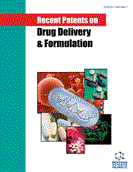Abstract
Background: Cancer is a condition in which some cells in the body grow uncontrollably and can also spread in other parts of the body. Among males, oral and lung cancers account for 25 % cancer deaths, while in females, breast and oral cancers cause 25% death. Breast and cervical cancers are the underlying cause of the high mortality rate among women. Owing to limitations of conventional cancer therapy like low drug specificity, less solubility, multidrug resistance, poor access to tumor cells and low bioavailability development of environmentally sensitive and target specific nanocarriers are imperative.
Objective: The objective of this study is to review advancements made in techniques to synthesize Mesoporous Silica Nanoparticles (MSN’s) as well as strategies to functionalize its silanol group for site-specific drug release in the tumor environment and to review recent patents published regarding it. To describe rationale for selection of MSN’s for cancer theranostics amidst other nanocarriers developed. Methods: In the first section of this review, the physical and chemical properties of MSNs making it an ideal delivery system for cancer therapy and diagnostics are discussed. In the next section, various techniques involved in synthesizing and loading MSNs, including the influence of basic components of MSNs and reaction conditions on its properties are reviewed. Then the wide application of MSNs and various exogenous and endogenous stimuli harnessed for site-specific delivery of cargo and recent patents on modifying environmental conditions for large scale synthesis of MSNs and its active targeting for cancer treatment and bioimaging are discussed. Results: Physico-chemical properties and synthetic protocols of MSNs justifying them to be a promising nanovector to overcome the ill effects of traditional chemotherapy. The superlative attributes of MSNs including, tunable size, morphology, high load volume, stability, ease of modifying external and internal surface leverage applications in various dimensions of therapeutics, diagnostics, and combinatorial drug delivery. MSNs surface functionalization can be harnessed for passive and active targeting by either coating the surface with polymers or attaching various ligands. Conclusion: An ideal nano-carrier must have high loading efficiency, easily detectable, and must have stimuli's sensitive, site-specific drug release. The patent study explores new dimensions on MSNs synthesis by claiming new cost-effective templates and silica source, a more safe environment for synthesis, reducing synthesis steps, duration of reaction, effective loading of low solubility drugs by magnetized nanocarriers, pathogen-specific release and development of novel photoluminescent rechargeable MSNs under mild conditions. It’s a challenging task for researchers to successfully translate their prototypes to industries and make it feasible for commercialization. We can further work on excellent targeting concepts and architecture of MSNs for the increased opportunity in cancer theranostics.Keywords: Breast cancer, mesoporous silica nanoparticles, targeting ligands, stimuli-responsive, templates, toxicity, patent survey.
[http://dx.doi.org/10.3322/caac.21492] [PMID: 30207593]
[http://dx.doi.org/10.4103/2349-3666.240996]
[http://dx.doi.org/10.1016/S0140-6736(12)60358-4] [PMID: 22460346]
[http://dx.doi.org/10.2174/1389200217666160921143616] [PMID: 27654898]
[http://dx.doi.org/10.1039/C5NJ01449B]
[http://dx.doi.org/10.3390/molecules24020332] [PMID: 30658511]
[http://dx.doi.org/10.1016/j.ijpharm.2019.04.067] [PMID: 31028801]
[http://dx.doi.org/10.1038/359710a0]
[http://dx.doi.org/10.1016/j.biomaterials.2011.04.077] [PMID: 21684000]
[http://dx.doi.org/10.1016/j.colsurfb.2020.110832] [PMID: 32070865]
[http://dx.doi.org/10.1021/cm960464p]
[http://dx.doi.org/10.1126/science.279.5350.548] [PMID: 9438845]
[http://dx.doi.org/10.1002/anie.200351752] [PMID: 12949872]
[http://dx.doi.org/10.1021/cm051014c]
[http://dx.doi.org/10.1073/pnas.0504926102] [PMID: 16051701]
[http://dx.doi.org/10.1021/ja065345h]
[http://dx.doi.org/10.1039/b615209k]
[http://dx.doi.org/10.1002/smll.201001337] [PMID: 20859948]
[http://dx.doi.org/10.1021/la103979c] [PMID: 21166445]
[http://dx.doi.org/10.1016/j.micromeso.2011.11.047]
[http://dx.doi.org/10.1002/asia.201301105] [PMID: 24115568]
[http://dx.doi.org/10.3791/51022] [PMID: 24379052]
[http://dx.doi.org/10.1002/adfm.201302988]
[http://dx.doi.org/10.1002/anie.201402002]
[http://dx.doi.org/10.2147/OTT.S113815] [PMID: 27980423]
[http://dx.doi.org/10.2147/IJN.S146955] [PMID: 29497295]
[http://dx.doi.org/10.2174/1567201812666150722123704.] [PMID: 26201344.]
[http://dx.doi.org/10.1016/j.jcis.2017.07.115] [PMID: 28783518]
[http://dx.doi.org/10.1016/j.polymer.2012.01.051]
[http://dx.doi.org/10.1021/la200719g] [PMID: 21553827]
[http://dx.doi.org/10.17576/mjas-2016-2006-17]
[http://dx.doi.org/10.1039/c3ra22805c]
[http://dx.doi.org/10.1186/2228-5326-3-39]
[http://dx.doi.org/10.1016/j.ijpharm.2013.12.045] [PMID: 24393764]
[http://dx.doi.org/10.1016/j.msec.2014.12.069] [PMID: 25686928]
[http://dx.doi.org/10.1016/j.bbagen.2016.07.001]
[http://dx.doi.org/10.1039/c1nr10580a] [PMID: 21892492]
[http://dx.doi.org/10.1021/mp400670f] [PMID: 24694363]
[http://dx.doi.org/10.1021/la801161g] [PMID: 18630936]
[http://dx.doi.org/10.1016/j.ejpb.2015.02.018] [PMID: 25720818]
[http://dx.doi.org/10.1016/j.ejpb.2013.10.008] [PMID: 24184803]
[http://dx.doi.org/10.1016/j.micromeso.2014.05.031]
[http://dx.doi.org/10.1016/j.ejps.2010.09.002] [PMID: 20850527]
[http://dx.doi.org/10.1038/nmat2442] [PMID: 19525947]
[http://dx.doi.org/10.1021/nn900918w] [PMID: 19739605]
[http://dx.doi.org/10.1016/j.biomaterials.2010.05.036] [PMID: 20561679]
[http://dx.doi.org/10.1186/1556-276X-6-93] [PMID: 21711578]
[http://dx.doi.org/10.1007/s12645-013-0035-6] [PMID: 26069499]
[http://dx.doi.org/10.1080/10717544.2018.1425779] [PMID: 29334793]
[http://dx.doi.org/10.1007/s13204-017-0593-8]
[http://dx.doi.org/10.1002/smll.201002300] [PMID: 21595023]
[http://dx.doi.org/10.3892/or.2017.5829] [PMID: 28731164]
[http://dx.doi.org/10.3892/etm.2017.4777] [PMID: 28962137]
[http://dx.doi.org/10.2147/IJN.S195900] [PMID: 31118604]
[http://dx.doi.org/10.1016/j.colsurfb.2015.04.002] [PMID: 25896537]
[http://dx.doi.org/10.1159/000366366] [PMID: 25401286]
[http://dx.doi.org/10.1111/j.2042-7158.2012.01547.x] [PMID: 27085860]
[http://dx.doi.org/10.3390/chemengineering2020024]
[http://dx.doi.org/10.1088/0957-4484/22/45/455102]
[http://dx.doi.org/10.1080/03639045.2017.1371734] [PMID: 28832225]
[http://dx.doi.org/10.1155/2019/3481397]
[http://dx.doi.org/10.1002/chem.201504629] [PMID: 26641630]
[http://dx.doi.org/10.1016/j.colsurfb.2018.12.038] [PMID: 30572156]
[http://dx.doi.org/10.1080/13102818.2019.1649094]
[http://dx.doi.org/10.1016/j.jconrel.2016.03.030] [PMID: 27016140]
[http://dx.doi.org/10.1016/j.jcis.2015.11.001] [PMID: 26550786]
[http://dx.doi.org/10.2147/IJN.S184634] [PMID: 30538451]
[http://dx.doi.org/10.1166/jnn.2017.13890]
[http://dx.doi.org/10.1021/la403494q] [PMID: 24380643]
[http://dx.doi.org/10.1002/chem.201400148]
[http://dx.doi.org/10.1016/j.biomaterials.2015.04.034] [PMID: 25941780]
[http://dx.doi.org/10.1016/j.colsurfb.2017.01.010] [PMID: 28088015]
[http://dx.doi.org/10.1039/C5NR02767E] [PMID: 26147639]
[http://dx.doi.org/10.1080/21691401.2018.1473412] [PMID: 29790797]
[http://dx.doi.org/10.1016/j.actbio.2018.05.022] [PMID: 29775731]
[http://dx.doi.org/10.1021/acsnano.5b00641] [PMID: 25859611]
[http://dx.doi.org/10.1002/smll.200800926] [PMID: 19051185]
[http://dx.doi.org/10.1021/nn2043803] [PMID: 22364198]
[http://dx.doi.org/10.3109/17435390.2011.649796 ] [PMID: 22264124]
[http://dx.doi.org/10.1002/adfm.201302988]
[http://dx.doi.org/10.1021/ja910846q] [PMID: 20230032]
[http://dx.doi.org/10.1021/nn100561e] [PMID: 20698555]
[http://dx.doi.org/10.1016/j.jconrel.2012.05.046] [PMID: 22684119]
[http://dx.doi.org/10.2174/2211738506666181031160108] [PMID: 30381088]
[http://dx.doi.org/10.1166/jnn.2012.6199] [PMID: 22962747]
[http://dx.doi.org/10.5772/58290]
[http://dx.doi.org/10.1166/jnn.2008.18282] [PMID: 18572669]
[http://dx.doi.org/10.1172/JCI45600] [PMID: 21670497]
[http://dx.doi.org/10.3390/ijms19030908] [PMID: 29562708]
[http://dx.doi.org/10.1016/j.micromeso.2017.01.036]
[http://dx.doi.org/10.1111/j.1751-1097.2011.00967.x] [PMID: 21749397]
[http://dx.doi.org/10.1021/acs.chemmater.7b02567] [PMID: 29123332]
 38
38 2
2
















